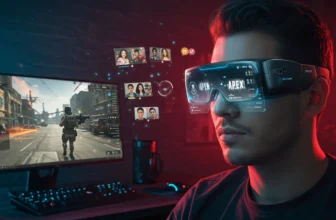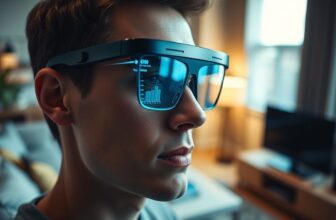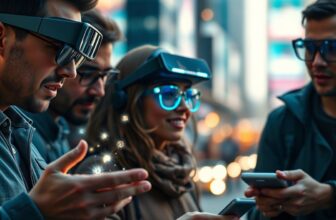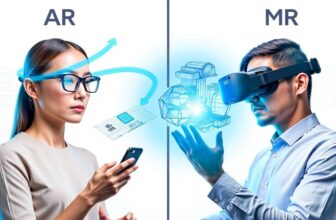AR glasses field of view comparison is critical for truly immersive experiences. As augmented reality technology advances, choosing glasses with a wide field of view becomes paramount. This article dives into the leading AR glasses currently available, analyzing which models deliver the most captivating and natural visual overlays for gaming, productivity, and beyond.
Understanding AR Glasses Field of View & Display Technology
The key to a truly immersive augmented reality (AR) experience lies in how convincingly digital content blends with the real world. A critical factor determining this perceived realism is the field of view (FOV) of the AR glasses. Simply put, FOV defines how much of your vision is filled with the augmented imagery. A wider FOV means a larger portion of your visual field is occupied by the AR content, creating a more natural and encompassing experience. A narrow FOV, conversely, can feel like looking at the world through a small window, diminishing the sense of presence and immersion. This is a core element in any thorough AR glasses field of view comparison.
However, FOV isn’t the whole story. It’s inextricably linked to the display technology used within the AR glasses. Early AR devices often struggled with limited FOV *and* low-quality visuals. Today, manufacturers are employing different technologies to push the boundaries of both. Some of the most prevalent include waveguide displays, micro-OLED, and micro-LED.
Waveguide displays work by projecting images onto a transparent surface (the waveguide) that directs the light into your eye. They are relatively power-efficient and allow for lightweight designs, but historically struggled with brightness and contrast. Micro-OLED, on the other hand, employs incredibly small OLEDs to create vibrant, high-contrast images. While offering superior image quality, they can be more power-hungry. Micro-LED is emerging as a promising technology, combining the benefits of both – high brightness, excellent contrast, and good power efficiency – but is still relatively expensive to produce and implement. The chosen display technology directly influences the achievable FOV, with some being more conducive to wider angles than others.
Caption: Typical brightness levels for different AR display technologies.
Beyond FOV and display technology, resolution and pixel density are crucial. A higher resolution within a given FOV translates to a sharper, clearer image. Pixel density (pixels per degree, or PPD) measures how closely packed those pixels are. A higher PPD minimizes the “screen door effect” – the visibility of individual pixels – enhancing realism. Improving PPD while maintaining a wider FOV is a significant engineering challenge. Essentially, you need to pack more pixels into a larger area.
The history of AR glasses FOV has been one of steady progression. First-generation devices like Google Glass offered a very limited FOV, around
The FOV reaches 20 degrees. The first HoloLens offered around 30 degrees. The Magic Leap 1 aimed for 50 degrees, though practical FOV was often less. More recent devices, such as the XREAL Air 2 Pro, are pushing towards 65 degrees, and we’re seeing prototypes aiming even beyond. By 2025, we can anticipate further advancements driven by new display technologies and optical solutions, with a realistic expectation of consumer-grade AR glasses reaching FOV levels of 70-80 degrees.
Ultimately, the most immersive experience will be achieved through a confluence of factors: a wide FOV, high resolution, high pixel density, excellent contrast, accurate colors, and low latency. The continued innovation in display technologies and optical designs will be paramount in delivering truly compelling AR experiences. The quest for the ideal AR glasses field of view continues, and the devices hitting the market now, and over the next few years, will determine the future of augmented reality.
The next step in an AR glasses field of view comparison is detailed analysis of available glasses.
Top AR Glasses field of view comparison – A Detailed Analysis
The quest for truly immersive augmented reality experiences hinges heavily on the capabilities of the hardware, and specifically, the AR glasses themselves. While software and content play crucial roles, a limited field of view (FOV) or poor display quality can quickly shatter the illusion of presence. This chapter provides a detailed analysis of leading AR glasses currently available, focusing on the factors that contribute to immersion. An important aspect of this analysis is an AR glasses field of view comparison, which will highlight the strengths and weaknesses of each device.
Magic Leap 2
Magic Leap 2 boasts a stated diagonal FOV of approximately 52 degrees. It utilizes a waveguide display with a resolution of 1440 x 1720 pixels per eye and a refresh rate of 90Hz. Weighing in at around 330g, it’s designed for enterprise use, prioritizing functionality and collaboration. Its dynamic dimming technology improves contrast in bright environments. However, user reports suggest the perceived FOV feels somewhat smaller due to the waveguide optics and the ‘sweet spot’ requirement for optimal clarity.
PROS
- Excellent hand tracking
- Good contrast and brightness
- Designed for extended use
CONS
- Relatively narrow perceived FOV
- High price point
- Bulky design
Microsoft HoloLens 2
The HoloLens 2 offers a diagonal FOV of around 52 degrees, similar to the Magic Leap 2. It features a resolution of 1600 x 1440 pixels per eye and operates at 60Hz. Weighing 566g, it’s noticeably heavier. Its strength lies in its robust 6DoF tracking and integration with the Microsoft ecosystem. While the display quality is improved over the original HoloLens, the FOV remains a limitation for truly immersive experiences.
Caption: Comparison of diagonal field of view across leading AR glasses.
XREAL Air 2 Pro
XREAL Air 2 Pro targets consumers with a more approachable design and price point. It offers a 48-degree FOV with a resolution of 1920 x 1080 pixels per eye and a refresh rate of 90Hz. Weighing just 65g, it’s significantly lighter than the enterprise-focused options. The Air 2 Pro utilizes a Sony Micro-OLED display, delivering vibrant colors and good contrast. While the FOV is slightly narrower, the lightweight design and excellent visual quality contribute to a comfortable and immersive experience, particularly for media consumption and gaming.
XREAL Air 2 Pro Review
- Excellent visual clarity
- Incredibly lightweight
- Good value for money
Rokid Max
Rokid Max aims for a cinematic AR experience with a 40-degree FOV and a high resolution of 2880 x 2880 pixels per eye. It features a refresh rate of 90Hz and weighs 200g. The Max utilizes a pancake lens design, which contributes to a slimmer profile. While the FOV is narrower than some competitors, the high resolution and pancake lenses deliver a sharp and clear image.
Ray-Neo X2
The Ray-Neo X2 also features a 40-degree FOV with a resolution of 1920 x 1080 pixels per eye and a 120Hz refresh rate. Weighing 83g, it’s relatively lightweight. It utilizes Micro-OLED displays and boasts a unique spatial audio system. The X2 focuses on providing a balanced AR experience with a focus on both visual and auditory immersion.
The differences in AR glasses field of view are becoming less pronounced, with manufacturers focusing on improving other aspects of the experience. However, FOV remains a critical factor, and the choice of the “most immersive” glasses ultimately depends on individual priorities and use cases.
Estimated progress towards wider FOV AR glasses by 2025.
As we move towards 2025, we can expect further advancements in display technology and optical designs, leading to wider FOVs and improved visual fidelity. The next chapter will delve into the other crucial factors beyond FOV that contribute to a truly immersive and comfortable AR experience.
While the AR glasses field of view comparison often dominates discussions, truly immersive augmented reality extends far beyond simply how much you can *see*. A wide field of view (FOV) is crucial, as detailed in the previous chapter, but it’s only one piece of a much larger puzzle. Factors like tracking precision, latency, interaction methods, ergonomics, and audio quality equally contribute to the feeling of presence and believability – the core of a compelling AR experience.
Beyond the Visual: The Pillars of AR Immersion
Six degrees of freedom (6DoF) tracking is paramount. This allows users to move naturally within the AR environment – to lean, duck, walk around virtual objects – and have those objects remain convincingly anchored in the real world. Older systems relied on limited degrees of freedom, causing frustrating drift and a disconnect between physical movement and virtual positioning. 6DoF, achieved through a combination of cameras and inertial measurement units (IMUs), provides a stable and accurate spatial understanding for the system. Without it, immersion quickly breaks down.
Closely linked to tracking is latency – the delay between a user’s action and the corresponding reaction in the AR world. High latency leads to motion sickness and a sense of disconnect. Ideally, latency must be below 20 milliseconds to be imperceptible. Modern AR glasses are continually striving to reduce this delay through optimized processing and efficient rendering techniques.
Interaction is another critical component. Hand tracking, increasingly common in devices like the Rokid Max and Ray-Neo X2, allows for intuitive manipulation of virtual objects. Eye tracking takes this a step further, enabling gaze-based interactions and foveated rendering (only rendering the area the user is directly looking at in high resolution, saving processing power and improving performance). Combined, these technologies translate into more natural and engaging interactions with augmented reality content.
Caption: Percentage of current AR glasses models supporting various input methods.
Comfort and Ergonomics: The Long-Haul Factor
Immersion is significantly hampered by discomfort. AR glasses need to be lightweight and well-balanced to be worn for extended periods. Poor weight distribution can cause strain on the nose bridge and temples, leading to fatigue and ultimately, a less enjoyable experience. Design choices such as adjustable headbands and nose pads are vital to accommodate diverse head shapes and sizes. The XREAL Air 2 Pro, for example, has focused heavily on a more glasses-like design to address this concern.
XREAL Air 2 Pro Comfort Review
- Lightweight design (85g)
- Adjustable nose pads
- Balanced weight distribution
- Slightly bulky compared to regular glasses
Finally, spatial audio dramatically elevates the sense of presence. By delivering sound that accurately reflects the location of virtual objects in the real world, spatial audio creates a more believable and immersive soundscape. This technique relies on algorithms that mimic how humans perceive sound, factoring in distance, direction, and occlusion. The combination of compelling visuals and accurate spatial audio creates a truly captivating augmented reality experience.
However, achieving this level of immersion comes at a cost. Increased FOV, higher resolutions, and sophisticated tracking all demand significant power. Battery life remains a major challenge for AR glasses. Improvements in battery technology and power-efficient processing are critical to unlocking the full potential of AR and enabling extended, untethered use.
| Feature | Impact on Power |
|---|---|
| Increased FOV | High |
| Higher Resolution | Very High |
| Advanced Tracking | Moderate |
| Spatial Audio | Low |
Building on the foundations of comfort and core interaction elements discussed previously, the ultimate goal for AR glasses remains fully immersive experiences. This hinges heavily on advancements to the AR glasses field of view comparison and the technologies that drive it. By 2025, we anticipate significant strides will be made, pushing the boundaries of what’s currently possible and truly unlocking the potential of augmented reality.
Currently, many consumer AR glasses hover around a 40-50 degree FOV, which, while sufficient for basic notifications, feels constrained for truly engaging AR applications. Pro-level headsets, such as those targeting enterprise and specific development scenarios, can reach upwards of 60-70 degrees. The sweet spot for convincing immersion is widely considered to be 90 degrees or greater, approaching the natural human field of vision. Achieving this requires breakthroughs in several key areas.
Display Technologies Driving Immersion
Micro-display technology is at the forefront of these advancements. We’re seeing a shift from LCD and OLED micro-displays to microLED, offering superior brightness, contrast, and power efficiency. Higher pixel densities – exceeding 4K resolution per eye – are becoming increasingly common, improving clarity and reducing the screen-door effect. Beyond resolution, new materials and manufacturing processes are allowing for smaller and lighter micro-displays, crucial for comfortable, all-day wear.
Holographic waveguide technology is particularly promising. These waveguides, which guide light to the eyes, are being refined to allow for wider FOVs without sacrificing image quality. ‘Folded optics’ and ‘freeform waveguides’ represent significant steps forward, minimizing distortion and maximizing light transmission. Companies are exploring multi-layer waveguides and dynamic diffraction gratings to further expand the usable FOV and control the image projected to the user.
Caption: Projected increase in average AR Glasses Field of View.
The Role of Artificial Intelligence
AI will play an increasingly vital role in creating more immersive experiences. Dynamic FOV adjustment, powered by eye-tracking, allows the system to render higher detail where the user is looking, conserving processing power and refining the visual experience. AI algorithms can also predict gaze patterns, pre-rendering content to further reduce latency. Furthermore, AI-powered distortion correction will become standard, ensuring a clear and comfortable viewing experience across the entire FOV.
Looking ahead to cost, advanced AR glasses with 90+ degree FOV capabilities will initially remain in the $2,000 – $5,000 range by 2025, targeting enterprise and prosumer markets. Wider consumer adoption, driven by falling component costs and increased competition, is expected around 2027-2030, with prices potentially dropping below $1,000. Adoption will be rapid in gaming, healthcare (surgical assistance, remote diagnostics), education (interactive learning), and enterprise (remote assistance, training, design).
PROS
- Increased immersion and presence
- Enhanced productivity in professional applications
- More engaging gaming experiences
- Potential for new forms of communication
CONS
- Significant development challenges remain
- Potential for motion sickness with wider FOV if not properly implemented
- Increased processing power requirements
- High initial cost
However, several roadblocks could hinder progress. Maintaining image clarity and minimizing distortion at wider FOVs remains a significant technical challenge. Power consumption remains a critical limitation, especially as resolution and FOV increase. And, critically, establishing robust and accurate eye-tracking, essential for foveated rendering and dynamic FOV adjustments, is still ongoing work.
Ultimately, the best AR glasses depend on your specific needs and budget. However, prioritizing a wider field of view is essential for a convincing AR experience. This AR glasses field of view comparison highlights that advancements in display tech are rapidly increasing immersion. Explore the options and embrace the future of augmented reality – it’s closer than you think!





